
This series explores what constitutes a "beautiful way of living," presented by the Beautiful Way of Living Research Institute(※). The institute reexamines practices and philosophies long embedded in Japanese daily life, proposing them through various activities in forms relevant to the modern era.
In this fourth installment, we explore the reality of Japan's cultural "annual events," which, even as lifestyles change, can serve as opportunities to "connect with nature," potentially enhancing well-being and leading to a "beautiful way of living."
Japan has the Five Festivals: the "Human Day" (Jinji) on January 7th, the "Joushi" on March 3rd, the "Tango" on May 5th, the "Shikisetsu" on July 7th, and the "Chouyou" on September 9th, alongside numerous other annual events. These events, aligned with the changing seasons, represent a dialogue between humans and nature, incorporating the power of nature at each time into daily life. Each form has been passed down and developed within regions and families. How well are these annual events known, practiced, and being passed on today? This report examines the awareness and actual practices of people in their daily lives.
*For more on the Beautiful Living Research Institute, click here
Awareness of events varies by generation. 14% of those in their 20s don't know about "New Year's"!?
When asked about awareness of 18 events including the Five Festivals, the most recognized was "New Year's" at 92.0%, followed by "New Year's Eve" at 91.3%, and "Setsubun" and "Obon" at 90.5%. Looking at age groups, awareness rates were generally lower among younger generations, with 14% of those in their 20s stating they "don't know New Year's."
Events showing significant generational gaps included "Little New Year," "Girls' Day," "Eighty-Eighth Night," "Boys' Day," and "New Year's Preparations," with over a 30% difference between those in their 70s and those in their 20s. "Girls' Day" and "Boys' Day," events many likely enjoyed as children, were recognized by only 57.0% and 50.0% of those in their 20s, respectively. While terms like "Hinamatsuri" or "Children's Day" might evoke images, this suggests low recognition of these events as traditional seasonal festivals.
Regarding the "Chrysanthemum Festival," one of the Five Festivals, overall recognition was only 17.3%. Other events like the "Summer Purification Rite," "Hassaku," and "Utsuki Yōka" also had recognition rates below 20%, indicating they are largely unknown.
Speaking of New Year's, about 30 years ago, not only financial institutions but also shops closed, and New Year's Eve was a busy yet quiet time to welcome the new year. This "New Year's" is commonly recognized among those in their 40s and older. Nowadays, many shops and various institutions remain open, making "New Year's" no different from everyday life for those in their 20s and Generation Z. The recognition of the event may be fading.
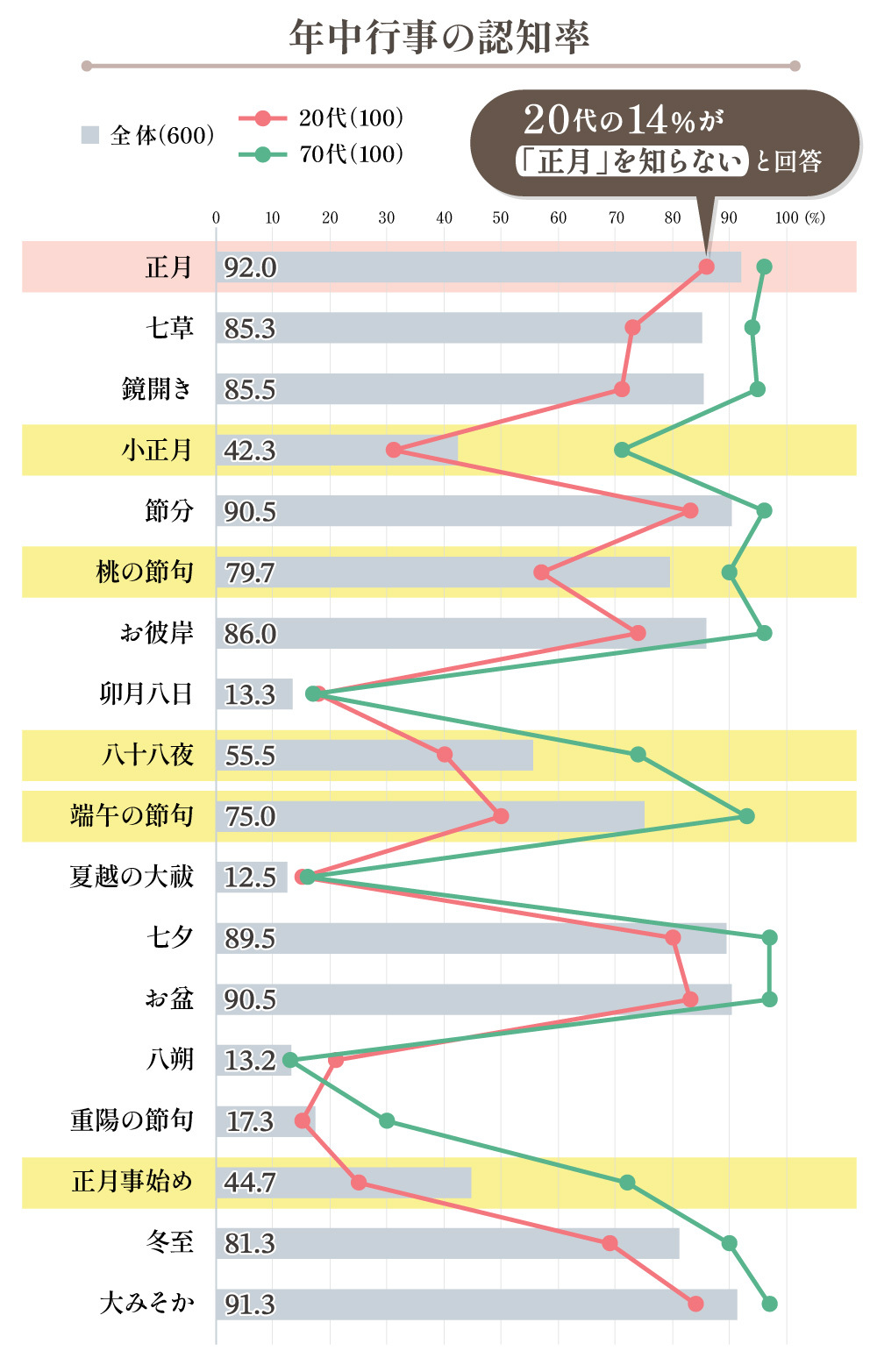
Even for "New Year's," only about 50% actually observe it. The reality is that full-time workers find it difficult to practice.
"New Year's" features special foods and decorations like osechi dishes, kagami mochi rice cakes, kadomatsu pine decorations, and shimekazari sacred ropes. "Little New Year" (Koshōgatsu) includes adzuki bean porridge and mochi flowers. These customs involve meals and decorations ingeniously crafted from what nature provides at each time. When asked about the extent to which these ceremonial foods and decorations are practiced, the highest practice rate for both ceremonial foods and decorations was during "New Year's," at 51.8% for ceremonial foods and 38.8% for decorations. The next highest practice rate for "ceremonial foods" was New Year's Eve at 38.3%, while for "decorations," Obon was 13.2%. In both cases, the results showed a significant gap compared to the practice rate for New Year's, indicating that even for well-known events, many customs are not actually practiced.
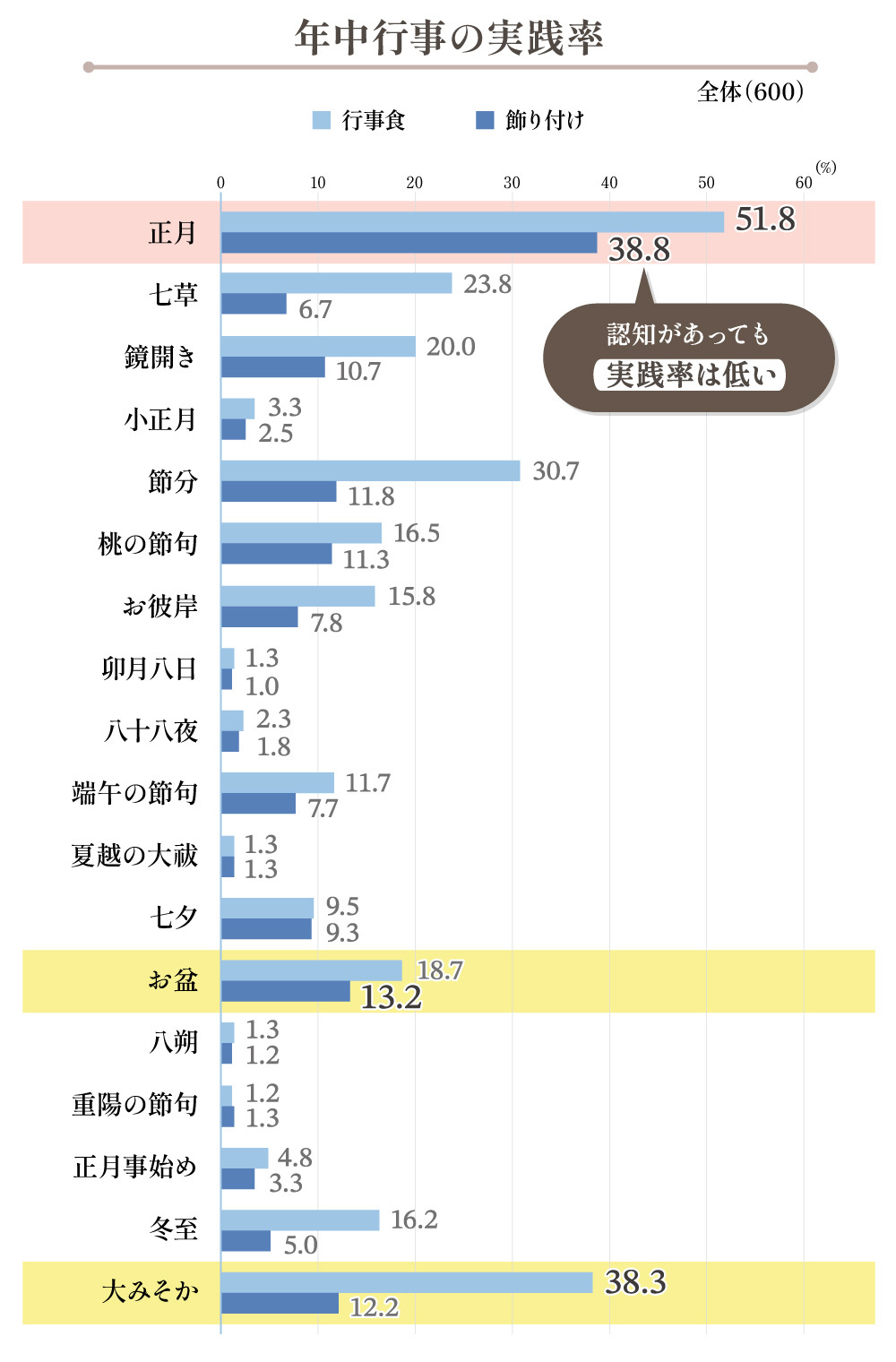
Looking at age groups, similar to awareness levels, practice rates were generally lower among younger generations compared to middle-aged and older generations. By occupation, full-time homemakers and part-time workers showed higher practice rates, while full-time workers had lower rates compared to these groups. The amount of time available to engage with household activities appears to significantly influence the practice of traditions. The increase in remote work due to the pandemic may lead to more event participation. As family structures and work styles evolve, it seems necessary to consider how events can be incorporated into daily life.

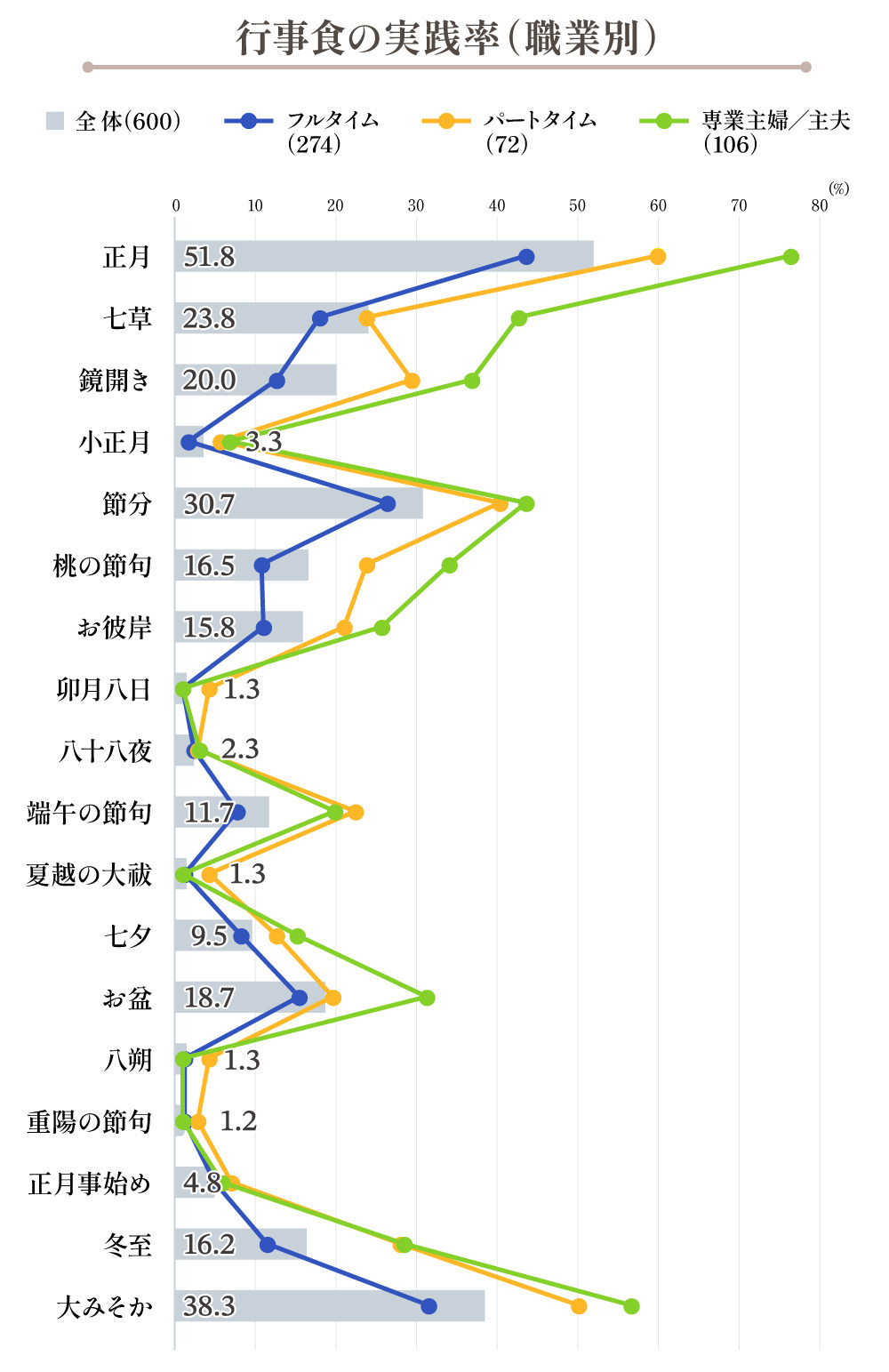
Intent to pass on traditions remains around 40% even for "New Year's." Can annual traditions continue to be passed down!?
Next, we asked about the intention to pass down each event, specifically whether respondents "feel it is important and want to pass it on to future generations." While New Year's had the highest practice rate, its intention to pass down was also the highest, though at 40.7%, it still fell short of a majority.
By age group, those in their 30s showed the lowest intent at 30.0%, followed by those in their 20s at 36.0%, indicating lower intent among younger generations. By occupation, full-time homemakers (housewives/husbands), who had the highest practice rate, showed an intent to pass on traditions at 55.7%, higher than other occupations, but still only slightly above half.
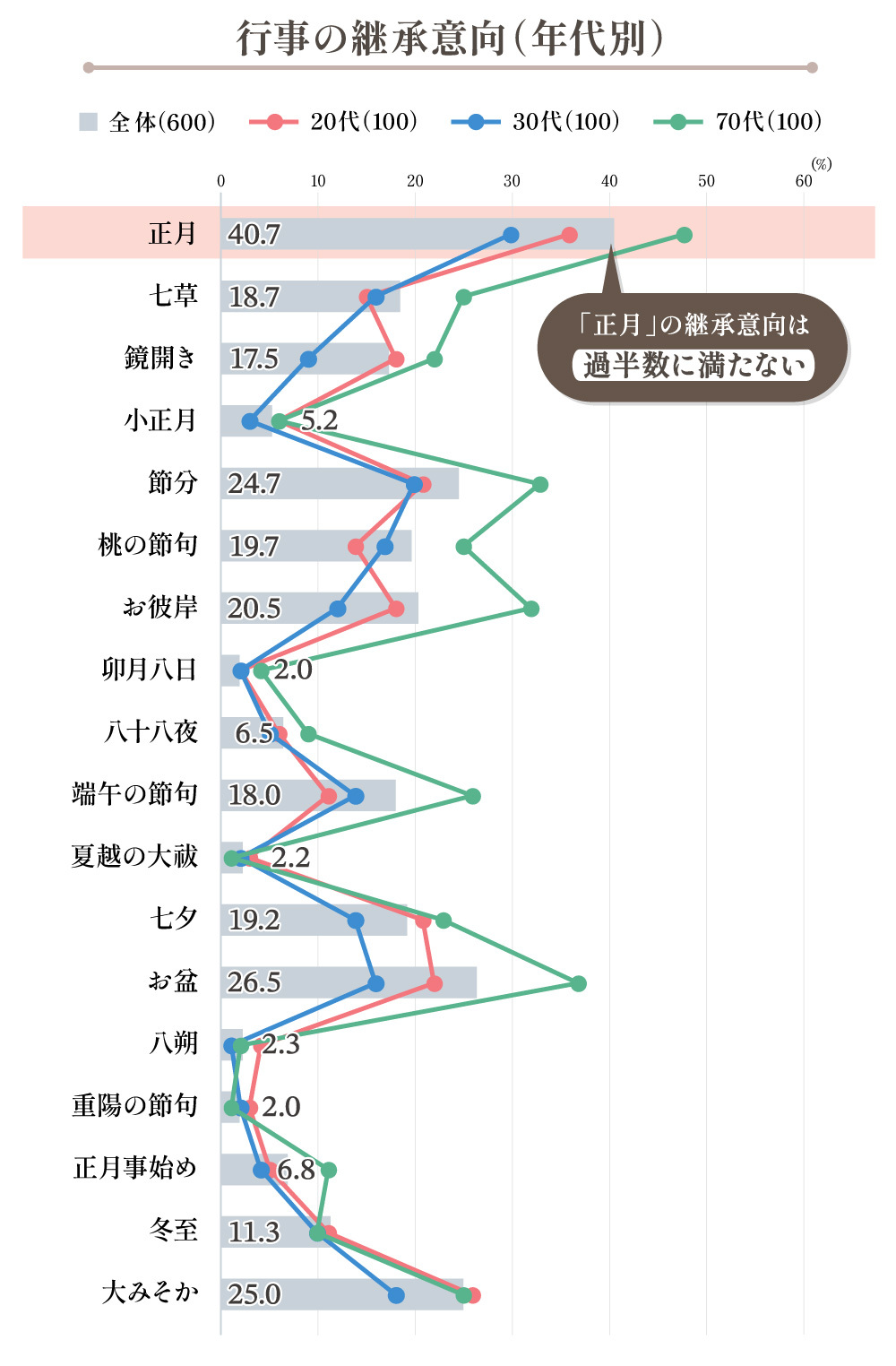
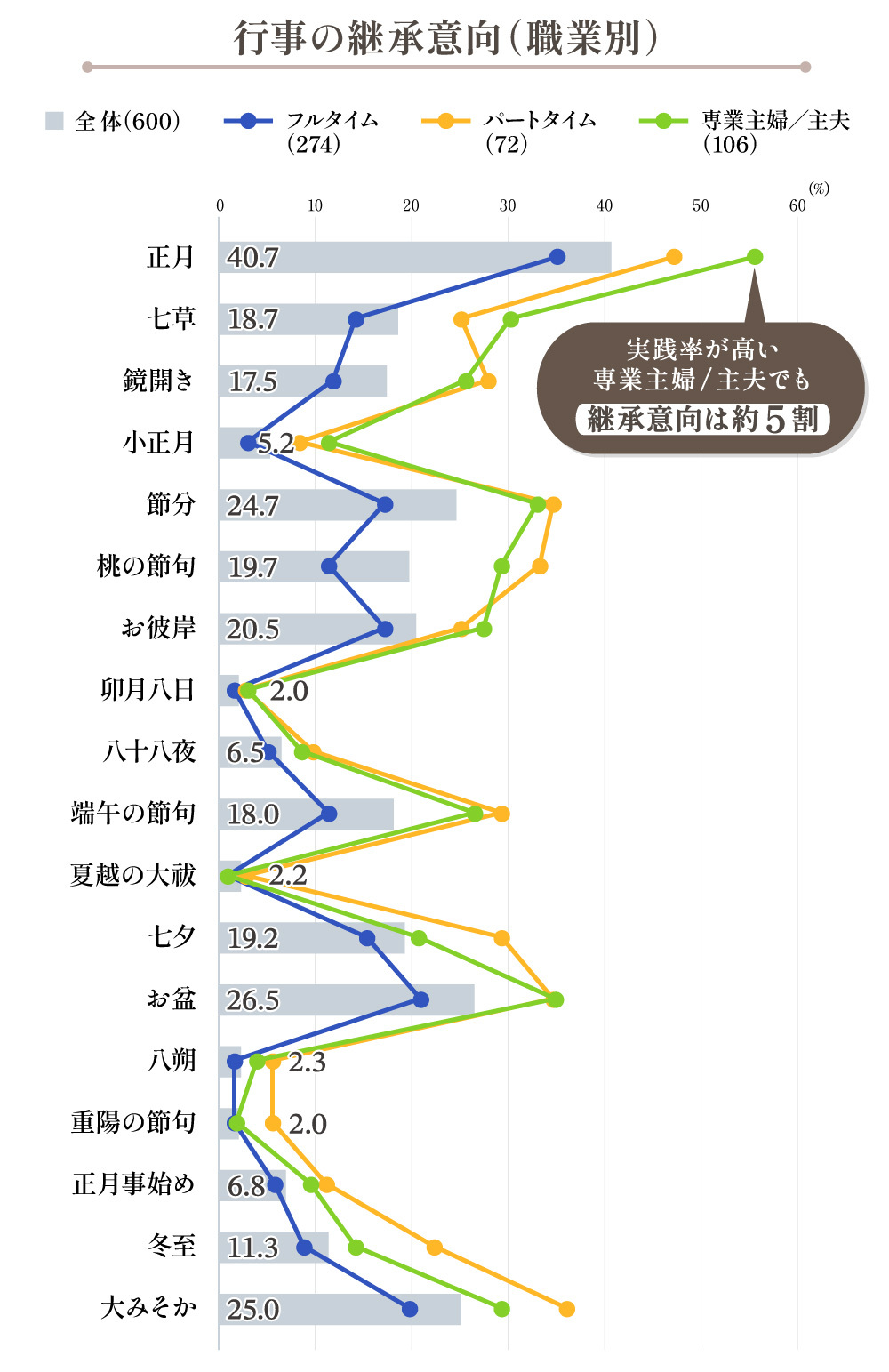
Higher Practice Leads to Higher Happiness: Enhancing Well-being Through Annual Events
Finally, let's examine the relationship between happiness and the practice of annual events.
Taking New Year's, the most commonly practiced event, as an example, we found that people who practice New Year's seasonal foods have a 17.9% higher happiness level than those who do not. Similar trends were observed for decorating practices and other events, indicating that people who practice seasonal events have higher happiness levels than those who do not. It's easy to infer that people with a certain degree of mental leeway are enjoying these events.
On the other hand, it's also possible that practicing these events increases happiness. Indeed, at events our Beautiful Living Research Institute held to enjoy seasonal traditions, participants shared feedback like, "I'm usually too busy to practice these events, but learning about them again and participating made me feel calmer." It was striking to see everyone leave with smiles.
Annual traditions can be seen as milestones that organize our lives. Even amidst busy days, pausing to connect with nature helps build our healthy lives, doesn't it?

Our findings reveal that while seasonal events are recognized, only about half of the general population (and less than half for some events) actually practice them. With the increasing number of dual-income households where both partners work full-time, there is a risk that these seasonal events may fade away without being passed down. On the other hand, we also discovered that practicing them, even amidst busyness, has the potential to increase happiness. This suggests there is value in highlighting the importance of practicing seasonal events.
New Year's dishes and decorations each carry meaning and wishes. Yet these are not mere superstitions; they represent the wisdom and ingenuity passed down by our ancestors. They engaged with seasonal ingredients and plants native to their land, recognized their inherent power, and incorporated them into their lives.
This attitude toward nature and the ingenuity of incorporating it into daily life are not only vital for organizing one's own existence but also essential for building a sustainable society. Shouldn't we strive to pass this down?
Even if the style and form of annual events change to suit each household, I believe that by practicing them, understanding their meaning, and savoring their enjoyment, we can pass them on to future generations.
Will we stand by and watch these annual events fade away? Or will we discover the modern value hidden within traditions passed down for generations? Having witnessed participants returning home smiling after our seasonal events, we feel the potential in pursuing the latter.
As family structures evolve and new lifestyles emerge amid the pandemic, we aim to propose ways for seasonal events to fit into the coming era.
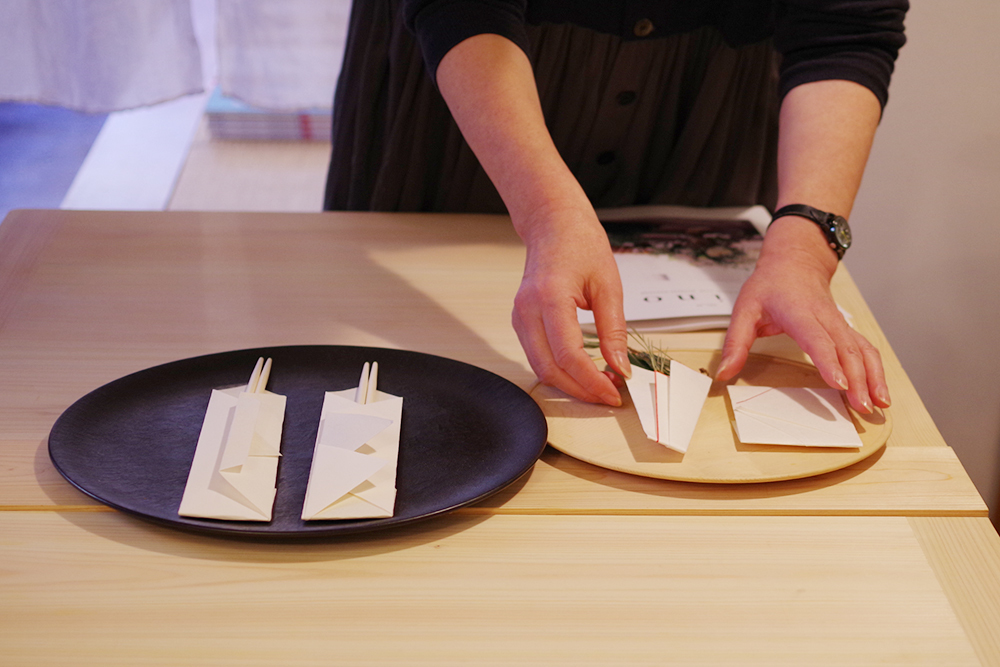
Scenes from the Annual Event
[Survey Overview]
・Survey Method: Online survey
・Survey Participants: 600 men and women aged 20 to 79 nationwide
・Survey Platform: Dentsu Inc. Macromill Inc.
・Survey Period: December 3–6, 2021
Beautiful Living Research Institute
We rediscover practices and philosophies long embedded in Japanese daily life, proposing "Beautiful Ways of Living" through various activities. These include "living in harmony with nature," "valuing processes and attitudes over convenience or effort," and "cultivating personal wisdom and skills"—adapted for contemporary acceptance. Our calendar app "Kurashi no Koyomi," which introduces and proposes seasonal lifestyle culture aligned with the "Seventy-Two Seasons," has reached 770,000 cumulative downloads, while the book "Kurashi no Koyomi" is a long-selling title with 10,000 copies sold. https://www.kurashikata.com/
Download the "Kurashi no Koyomi" app here. https://www.kurashikata.com/app/


















